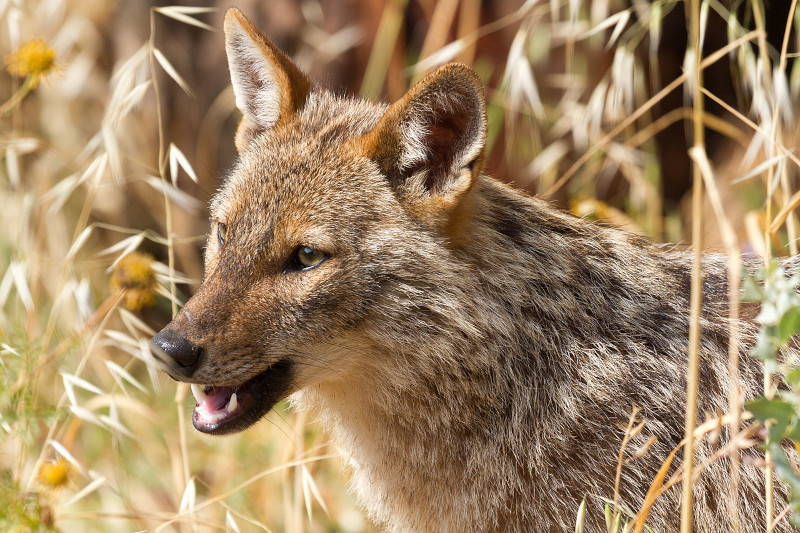
Golden Jackal Facts
- This beautiful wild canid most frequently goes by the descriptive common name of the Golden Jackal, due to its appearance. It also has another, slightly less often used general name, though. That’s the simple yet deceptive term of the common jackal.
- Within scientific circles, though, it’s better known by its formal moniker. Thankfully for the layperson, that’s a much easier to pronounce name than many such titles. That’s because it bears the formal name of the Canis aureus. By either term, it’s impressive.
- The mammal received its technical title due to the efforts of the esteemed Carl Linnaeus. The Swedish zoologist accomplished the first recognition of the animal as a separate and distinct species. He managed this noteworthy deed in 1758.
- Both common names remain somewhat deceptive in nature, however. Despite those terms, the creature holds no close genetic relationship to jackals. Instead, it’s actually much more closely related to coyotes and wolves. It also has 6 known subspecies.
- Fortunately, the magnificent Golden Jackal has a population base that appears to be both stable and sizeable. That also seems to hold true throughout the entirety of its known native range. The IUCN, therefore, now lists it as Least Concern on its Red List.
- It nevertheless faces some potential threats to its existence, at least. Most of these stem either directly or indirectly from the actions of mankind. They include habitat degradation and loss. It also faces the danger posed by climate change, as all species.
Related Articles
Golden Jackal Physical Description
The gorgeous Golden Jackal immediately captivates those who encounter it. The amazing product of evolution typically does so, however, due to its appearance more than its sheer size. That’s due to the fact that it resembles the gray wolf, but remains somewhat smaller.
The magnificent animal also possesses a more elongated torso than that genetic cousin. It additionally attains a lighter weight, shorter legs and tail, a narrower muzzle, and a less prominent forehead. These tendencies also hold true for individuals of both genders.
It does follow a pattern similar to other wild canids in that it displays a certain degree of the physiological characteristic of sexual dimorphism. In its specific case, this trait manifests in terms of simple physical size. More specifically, males of the species reach greater sizes.
Mature males typically reach a body length of approximately 28 – 33 in (71 – 85 cm). These same specimens grow to an average body weight of roughly 13 – 31 lb (6 – 14 kg). An average height for the animal at the shoulder also measures between 18 – 20 in (45 – 50 cm).
Females of the Golden Jackal, though, generally reach a body length that equals about 27 – 29 in (69 – 73 cm). Their weight also remains slightly less, averaging 15 – 24 lb (6.8 – 10.9 kg). Despite these differences, they attain the same average height at the shoulder, though.
Otherwise, both genders display the same general appearance. The fur develops as coars and relatively short. As the name implies, the base color is a golden hue. A mixture of brown, white, and black hair appears on the back, and a ginger or cream on the stomach.
- Kingdom: Animalia
- Phylum: Chordata
- Class: Mammalia
- Order: Carnivora
- Family: Canidae
- Genus: Canis
- Species: C. aureus
Golden Jackal Distribution, Habitat, and Ecology
Thankfully, the Golden Jackal evolved as native to a relatively large swathe of the globe. The location of that range might not surprise many people. The full extent of that zone of habitation, though, might do so. It’s unknown if the animal ever appeared elsewhere.
More precisely, it lives in an area that includes most of Asia and northern Africa. Yet, the creature also makes its home in portions of southeast Europe. The oldest known fossil evidence of the mammal in Europe occurs in Greece, and dates back roughly 7,000 years.
This marvelous creation of Nature displays decided preferences in its choice of habitat. The majority of its numbers make their homes in either regions of dry, open country, dry, short grasslands, or the steppe landscapes so abundant in most of its known range.
Though rare, some few individuals do occur in foothills and low mountain regions. In all regions it does appear in, however, the wild canid displays further habitat requirements. It’s generally abundant in valleys, near rivers, lakes, canals, and even seashores.
The intriguing Golden Jackal also evolved as a comparatively social creature. Its primary social structure isn’t pack based, though, like some. Instead, breeding pairs often live with young offspring. This distinguishes it further from many other varieties of wild canines.
Though mainly carnivorous, it supplements its diet with a variety of fruits and insects. It hunts its main prey opportunistically, and usually prefers smaller mammals, such as wild or domestic fowl. It will, however, attack prey as large as they young of larger animals.
Species Sharing Its Range
Check out our other articles on 7 Captivating Mammals of Canada, American Sweetgum, Uluru, European Honey Buzzard, Spiny Butterfly Ray, Monarch Butterfly, Alligator Snapping Turtle
